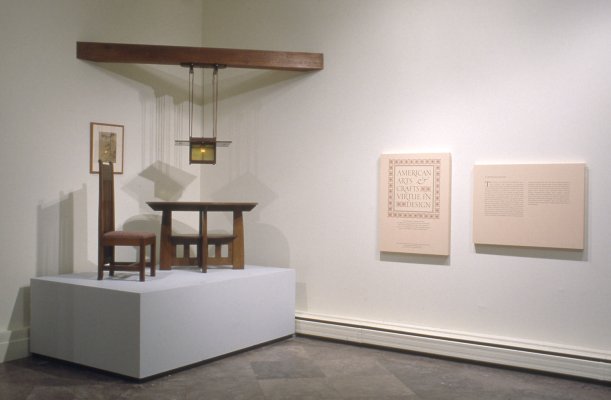American Arts and Crafts: Virtue in Design
Saturday, January 14, 1995–Sunday, March 5, 1995

Installation view of American Arts and Crafts: Virtue in Design. Photograph by Tom Loonan.
1905 Building
American Arts and Crafts was a showcase for significant examples of late 19th and early 20th century furniture, ceramics, and metalworking that exemplify the Arts and Crafts doctrine of functional design, natural materials, and sound handcrafted construction. Organized by the Los Angeles County Museum of Art, the exhibition was a project of ART ACCESS, a program of the American Federation of Arts. In addition to its showing at the Albright-Knox, American Arts and Crafts travelled to the Terra Museum of American Art, Chicago, Illinois; the Indianapolis Museum of Art, Indianapolis, Indiana; the Nelson-Atkins Museum of Art, Kansas City, Missouri; and the Philbrook Museum of Art, Tulsa, Oklahoma.
The Arts and Crafts movement began in England at the end of the 19th century as an aesthetic and social protest against the replacement of handcraft by mechanized production. British exponents, the critic John Ruskin and the architect A.W.N. Pugin, followed by the social reformer and designer William Morris, sought to counteract the debasing effects of industrialization by elevating the decorative or “minor” arts to the fine arts.
The movement took on a distinctly American character when transplanted to the United States in the 1890s, where it flourished into the first two decades of the 20th century. The Arts and Crafts movement succeeded as a middle-class phenomenon in America because its proponents adapted handcrafts to industrial methods of production and marketing.
American Arts and Crafts: Virtue in Design featured objects by all of the movement’s premier practitioners, including architects, artists, and craftsmen such as Frank Lloyd Wright, Gustav Stickley, Louis Comfort Tiffany, Rookwood Pottery, and Frederick Hurten Rhead. Arts and Crafts artists from the Western New York area were highlighted by the work of Charles Rohlfs Workshop, the Roycrofters, and Gustav Stickley’s Craftsman Workshops. The exhibition was accompanied by a companion book written by Leslie Greene Bowman, Curator of Decorative Arts at the Los Angeles County Museum of Art.
This exhibition was organized by Curator of Decorative Arts Leslie Greene Bowman at the Los Angeles County Museum of Art and circulated by the American Federation of Arts.
Exhibition Sponsors
This exhibition had major support from the Lila Wallace-Reader’s Digest Fund. In Buffalo, the exhibition was made possible through the generous support of Key Bank.
This exhibition had major support from the Lila Wallace-Reader’s Digest Fund. In Buffalo, the exhibition was made possible through the generous support of Key Bank.